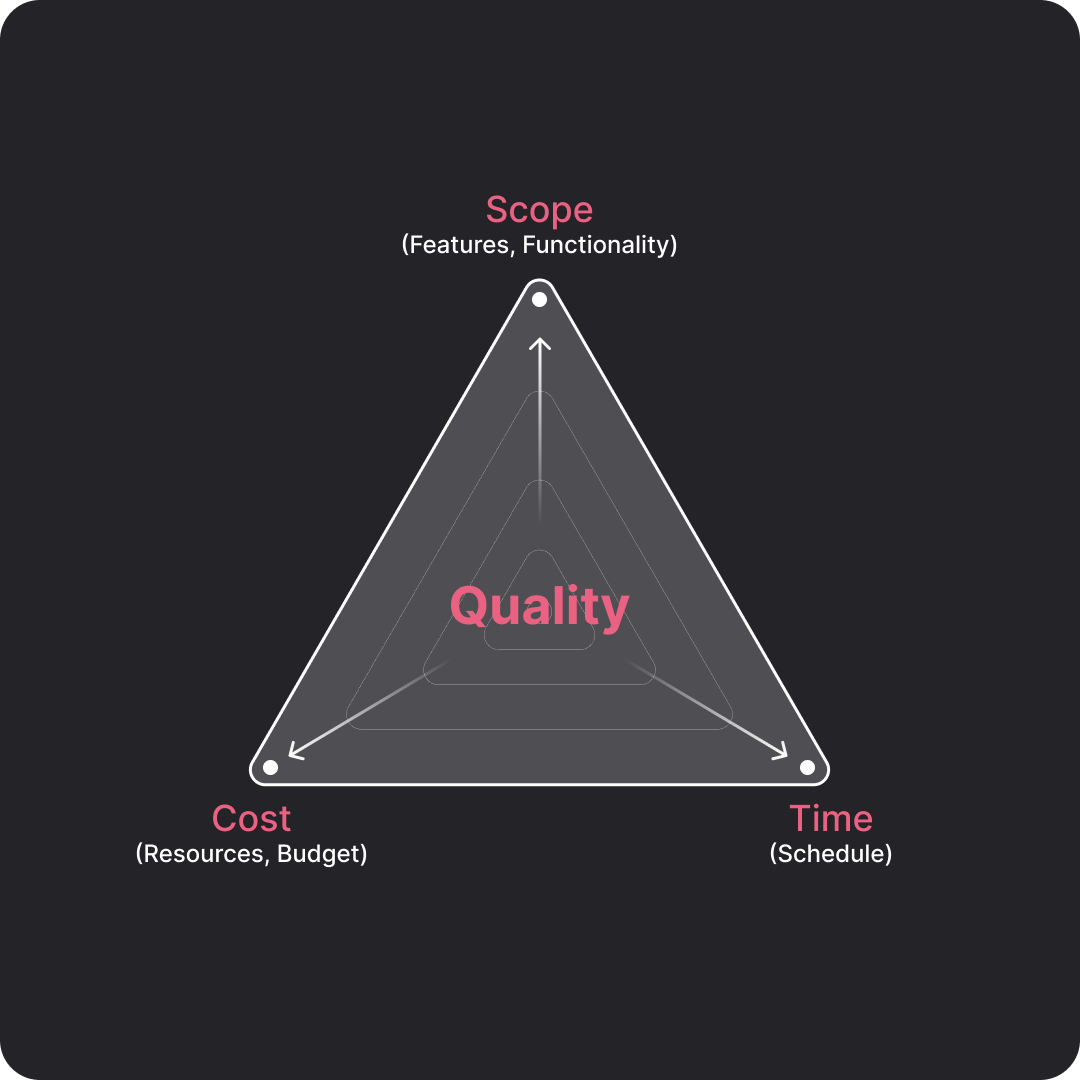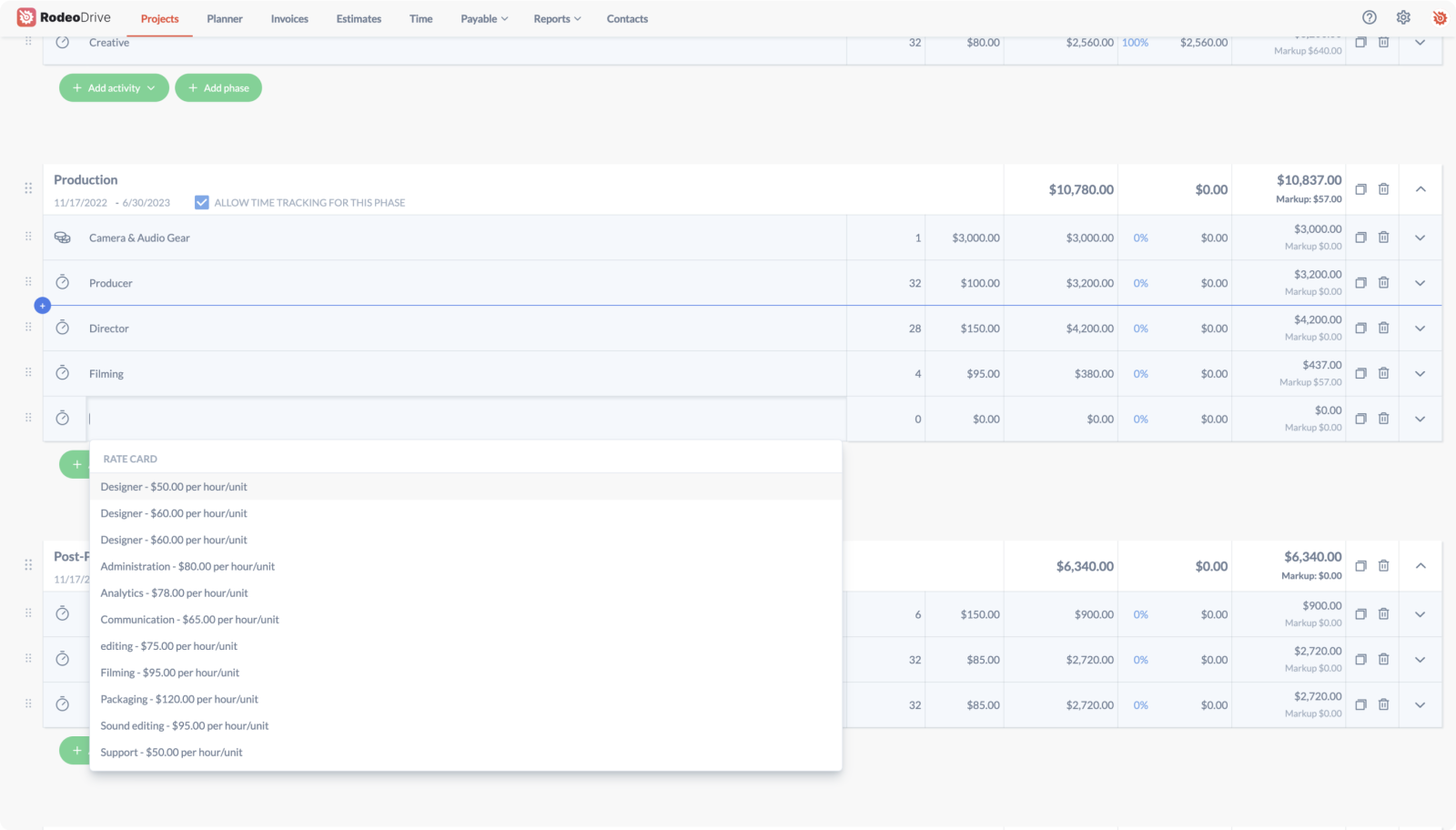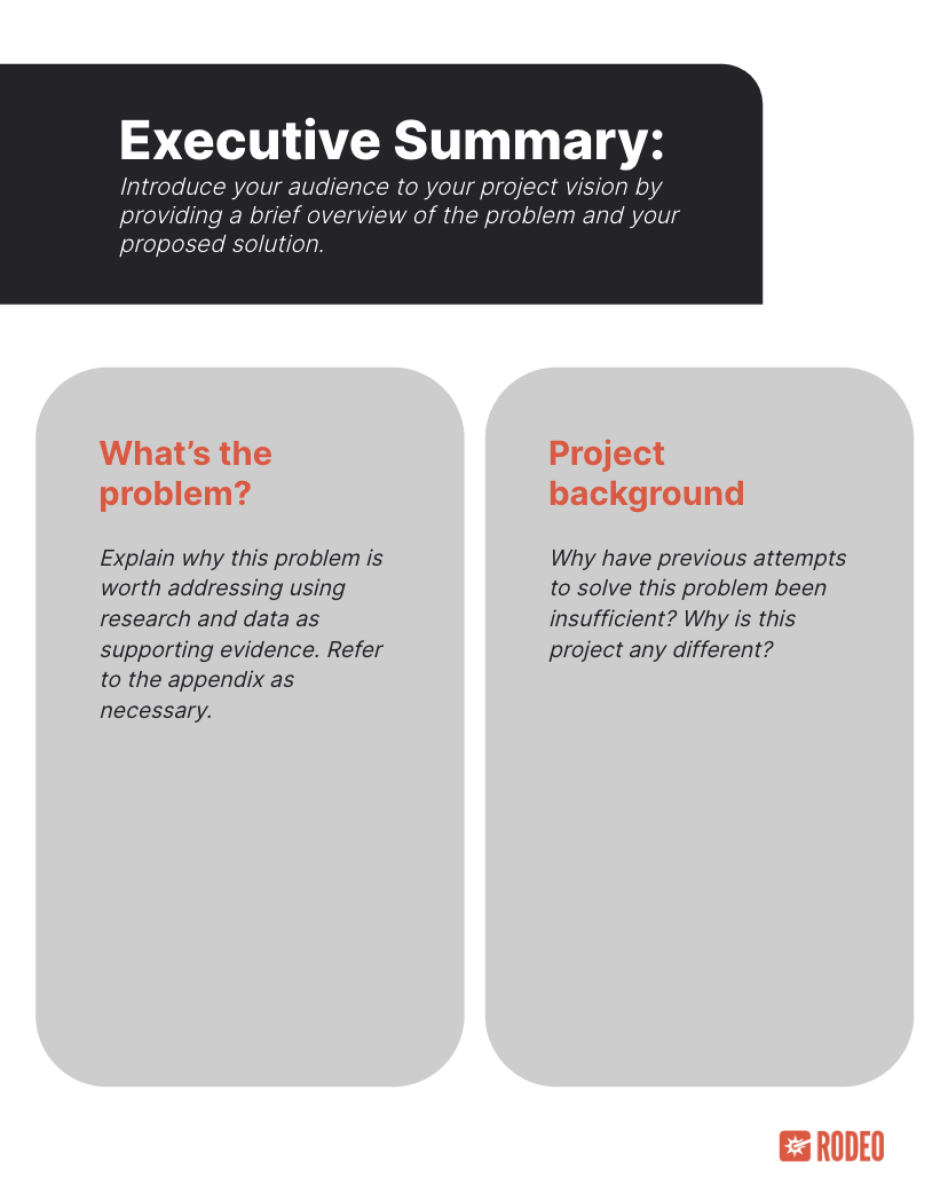Crafting a Persuasive Project Proposal: Key Techniques and Tips
Creating a project proposal can be intimidating at first. Proposals help stakeholders understand a project’s expected deliverables as well as what resources are necessary for the project to be successful. Once a project proposal has been approved, the project team can begin.
But the question is, how can you write a persuasive project proposal that will help more projects get approved?
In this blog, we’ll break down what a project proposal is, the different types of proposals, what goes into a proposal, as well as tips to write one like a pro. We’ve also created a template that you can use to make your proposals look polished and professional.
Without further ado, let’s begin!
What is a project proposal?
A project proposal is essentially your pitch on your plan and vision for a particular project. The goal is to win stakeholder approval so you can move forward with the necessary budget and resources to make the project a success.
Your project proposal document should include everything stakeholders need to know about a project, including your timeline, budget, objectives, and goals. Gaining stakeholder buy-in will be difficult if you’re not on the same page, so creating a written document of project details ensures everyone’s alignment.
Because stakeholders will often sift through several proposals before selecting one to proceed with, your project proposal must be concise and efficient. If nothing else, it’s crucial to leave stakeholders with a clear understanding of the project’s core value proposition.
Related: The Ultimate Guide to Managing Projects Effectively
Project proposal vs. estimate
While project proposals and estimates do have some overlap, they have some key differences.
For one, proposals are typically submitted as part of the competitive process of winning new clients, so they involve you pitching how you’ll create value for the project. Budget or project estimates are just one detail of many that are typically included in a project proposal.
On the other hand, the main purpose of an estimate is to provide an approximation of the costs necessary to carry out the project. A detailed estimate is likely something you’d present to stakeholders once they’ve decided yours is the winning project proposal.
You might’ve also heard the term ‘project charter’ before, as this is another step in the project creation process. A project charter documents your objectives, stakeholders, risks, goals, and overall budget.
But whereas proposals are usually persuasive, your project charter is just a reference document based on the details of your proposal. Your project sponsors will look over your project charter and give their final stamp of approval. The other key difference between the two is that proposals are created in the initiation phase, whereas project charters are created in the planning phase of your project.
Pro tip: The easiest way to create a project charter is with our project charter template.
We get it though – managing all of the different documents you need for your project can be confusing. Luckily, project management software tools like Rodeo Drive can help. Try Rodeo Drive for free and create a project estimate in just a few clicks.
Types of project proposals
The type of project proposal you’ll need to write depends on your goals and project. In general, though, there are six types of project proposals that project managers should be familiar with.
Here’s a breakdown of each:
Solicited
Solicited project proposals are created in response to a Request for Proposal (RFP). RFPs are essentially project announcements where stakeholders solicit bids from teams that are qualified to complete the project.
RFPs typically come with very specific instructions that you’ll need to adhere to when creating your project proposal. Because solicited proposals are more competitive, you must hone your research and persuasive writing skills.
Unsolicited
Proposals are considered unsolicited when they’re submitted without an RFP, meaning the project stakeholders did not ask for your project proposal. While this makes unsolicited project proposals less competitive, there’s often some uncertainty on whether the stakeholders actually need your help.
You might want to consider creating an unsolicited project proposal if you’ve identified a problem or opportunity during your everyday work that requires resources to solve, even if stakeholders aren’t yet aware of this opportunity.

Informal
An informal project proposal is developed when project managers are asked to create a proposal – either verbally or through an informal communication channel – without an RFP. Since these proposals are less formal, you’ll have fewer guidelines and context, meaning they typically require more research.
Renewal
A renewal project proposal is sent to an existing or past client with the goal of them partnering with your organization again on a new project. As such, be sure to emphasize your previous project success and persuade them on your ability to create future results for them.
Continuation
Continuation project proposals are less about persuading a potential client and more about providing information about an ongoing project – usually when a project is entering a new phase. These proposals are lower stakes and less complicated since stakeholders have already approved the project in the past and you’re not competing against other potential project teams.
Supplemental
Supplemental project proposals are sent to stakeholders already involved in your project, typically when you’re asking them to contribute more resources to ensure the project is a success. This might occur at the beginning of a project, or if a particular resource is in short supply and you cannot complete the project without it. Regardless, it’s critical to be persuasive in a supplemental project proposal.
How to write a persuasive project proposal in 6 steps
Now that we’ve covered the different contexts for project proposals, it’s time to break down what goes into writing a persuasive one.

1. Craft an executive summary
Just like the essays you wrote in school, it’s important to begin your project proposal with an introduction that hooks readers in. The best way to grab attention in a proposal is with an executive summary that provides a brief overview of the problem the project will address, your solution, and the impact the project will have.
2. Establish the problem and project background
Next, it’s important to demonstrate a thorough understanding of the problem. Your goal should be to convince your audience that this problem is worth addressing and that you’re the right person to do so.
This is where you should begin including research and statistics as supporting evidence. Generally, this section should provide a brief overview of what’s known about the problem and why previous attempts to solve the problem have been insufficient.
3. Present your proposed solution
Now that you’ve described the problem, it’s time to pitch your solution. Showcase your project approach by including your vision statement, milestones, team, and deliverables that you’ll use to solve the problem you just finished framing.
Your project scope will largely determine what should be included in this section, but you should expect this section to be the longest part of your project proposal. Your audience should leave this section with a clear understanding of what your plans are and how you’ll execute them.
4. Establish your goals and deliverables
The goals and deliverables section of your project proposal is important because it ensures your expectations are in alignment with that of your stakeholders.
Your deliverables are the expected outcomes of your project, which might be a report, product, or new system. If you fail to produce the project deliverables that stakeholders expect from you, you’ll likely leave them unsatisfied, which is why they must be clearly outlined in your project proposal.
The same goes for your goals. It’s a good practice to set Objectives and Key Results (OKRs) or SMART goals – in other words, goals that are specific, measurable, attainable, relevant, and time-based – and include a timeline for when you expect these goals to be met during the project.
Also read: The Project Management Checklist: 12 Steps to Follow
5. Outline the budget and resources needed
Now that you’ve sold your audience on your proposed solution, it’s time to outline what resources you’ll need to see the project through.
Your project budget should include all items that will eat up your budget, including supplies, team salaries, and project management tools, to name a few. Every dollar in your budget should be accounted for in the project proposal.
Related: 12 Best Project Management Budgeting Tools to Try in 2023
Additionally, providing a breakdown of costs – meaning an explanation and additional research on why each resource is a necessary budget item – can be very helpful in gaining stakeholder trust and buy-in on your project proposal.
You might want to also consider overestimating the number of resources you need so you can avoid having to create a supplemental project proposal to ask for additional funds later on.
6. End with a strong conclusion
A strong conclusion determines how your audience will feel about your project proposal after they finish reading. Your final section should summarize the problem and solution you’ve already discussed and emphasize why you’re the best project team to work on it.
Try to end on a positive note by highlighting the outcomes you’ll be able to deliver should your project proposal be selected.
Manage your projects with Rodeo Drive
8 tips to write project proposals like a pro
Like most things, writing a great project proposal requires practice. If you’re new to project management and proposals or just want to refine your skills, here are a few tips to help you out.
Tip #1: Address the project management triangle throughout
The project management triangle – also known as the triple constraint – includes your project’s time, scope, and cost. These three things will be top of mind for the stakeholders receiving your project proposal, so you should not hesitate to address them very clearly.
It’s especially important that the project scope is universally agreed upon, as scope creep has the power to derail your budget and project timeline. Once your project proposal is approved, make sure all parties agree on the project management triangle.

Tip #2: Add a cover page and table of contents
Project proposals contain a lot of dense information, and you wouldn’t want your audience to begin reading without understanding what’s ahead first. You can easily do so by adding a cover letter and table of contents, which provide important context while also making your project proposal look significantly more professional.
Tip #3: Keep it brief
Think of your project proposal as an elevator pitch – you want to leave your audience with an understanding of your project vision without bogging them down with too many details. Try to keep your proposal to around two pages, with an appendix adding additional supplemental information if necessary.
Tip #4: Tailor it to your audience
Researching your audience ahead of time can help you decide the appropriate tone as well as the level of explanation you need to incorporate into your project proposal.
For example, if your stakeholders are well-versed in the project area, you don’t need to dedicate as much time explaining terms or processes as you would if your audience was unfamiliar with the industry at hand.
Tip #5: Set SMART goals
You should aim to leave your stakeholders feeling confident in your ability to monitor your success along the way. The best way to do this is by making sure you’re setting SMART goals.
While goal setting, it’s also crucial to set KPIs or milestones that prevent anything from slipping through the cracks. Your project management KPIs should help you make sure the project deliverables are on track for high-quality and on-time delivery. Also, be sure to communicate how often you’ll be sending project reports to stakeholders.
Related: Marketing Management Tasks to Prioritize for Successful Results
Tip #6: Include an appendix
As we’ve previously mentioned, your project proposal should be concise. To avoid bogging your proposal down with the nitty-gritty details of the research you’ve done, you should consider including an appendix that you refer to throughout instead.
This might include additional images, customer testimonials, or other data points that support the claims you’re making in the proposal. This is also where you would cite your sources so your audience knows where you got your information from.
By referring to research in your appendix, you can demonstrate that your project plans are data-driven and informed – not just based on feelings.
Related: Project Administration: A Crucial Part of Project Management
Tip #7: Have someone proofread
Whether or not your team is chosen to spearhead a project might come down to the quality of your project proposal. When the stakes are high, there’s no room for typos and grammatical errors.
This is why it’s a good idea to get a second pair of eyes on your project proposal before you send it to stakeholders. This person can also look for inconsistencies and missing information in addition to helping you identify minor errors.
Remember – you want your audience to trust you to deliver on your project proposal, and you don’t want preventable errors getting in the way of that. It’s important to present yourself as a strong communicator.
Tip #8: Use a template
Making sure your project proposal is visually appealing can take valuable time away from the research and planning that goes into your pitch. This is where templates come in handy.
Project proposal templates are the best way to cut down on wasted time while also ensuring your proposals feature a high-quality graphic design. Plus, you can reuse templates for future project proposals rather than having to build a new one from scratch every time.
At the end of this article, you’ll find an eye-catching template that you can download and customize to meet your needs.
Planning your project proposals with Rodeo Drive
To say that project management is time-consuming would be an understatement. Fortunately, project management tools like Rodeo Drive can cut down on your wasted time to help you increase your productivity.
Rodeo Drive is an all-in-one project management tool that supports project managers through every stage of a project’s lifecycle. With budgeting, time tracking, invoicing, and reporting, Rodeo Drive is the single source of truth for your projects.
When you create a new project in Rodeo Drive, you’ll be prompted to begin with a budget. Rodeo Drive’s budgets are broken down into phases, activities, and tasks to help you plan out our project and properly estimate how much everything will cost.

Once your budget is built, sending an estimate to your client is effortless. In fact, you can customize your estimate with your company branding before sending it off to the client straight from Rodeo Drive in just a few clicks.
And once that estimate is approved, your team can track time towards the project, which will automatically update your budget in real time.
.png)
Want to view insights on employee productivity or project profitability? Your project data is available through Rodeo Drive’s "Reports" tab.
Interested in trying it out for yourself? Try Rodeo Drive for free – no credit card required.
Free project proposal template

As we’ve already mentioned, using a template to build your project proposal can save you a lot of time. Plus, it can prevent you from forgetting a section.
This free project proposal template provides a sample project proposal outline while also ensuring your proposals are aesthetically appealing to stakeholders.
Click here to download a free project proposal template
Related articles:
The Ultimate Guide for Creative Project Management in 2022
What Does Project Management For Creatives Look Like?
How to Create a Winning Marketing Project Plan







